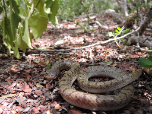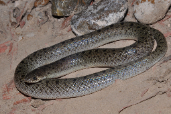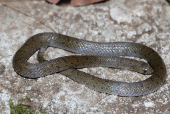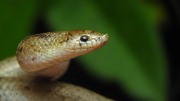Tamaulipan Hook-Nose Snake (Ficimia streckeri)
Description: Also called the Mexican hooknose snake. It is usually 5 to 11 inches in total length (including tail). Maximum total length of almost 19 inches. It is typically brown or gray in color, with as many as 60 brown or brown-green blotches down the back, which are elongated to almost appear as stripes. Its underside is white or cream-colored. Its most distinctive feature is an upturned snout, much like hognose snakes, which gives it its common name. However, unlike hognose snakes, Mexican hooknose snakes have smooth dorsal scales. Also distinctive is the arrangement of the head shields. There are no internasals, and the rostral separates the prefrontals and contacts the frontal. The smooth dorsal scales are arranged in 17 rows at midbody. Ventrals 126–155, subcaudals 28–41.
Habitat: The species' habitats include thorn brush woodland (e.g., cactus, mesquite, acacia, paloverde; especially near water or along the edges of agricultural fields) and lower Rio Grande floodplain in lowland southern Texas and northern Tamaulipas (also recently irrigated lawns near human habitation in habitats encompassed by towns or suburbs), tropical deciduous forest in Veracruz, Hidalgo and southern Tamaulipas. This snakes burrows into soft soil. It is able to adapt to degraded habitats.
Range: F. streckeri is found primarily in the Mexican states of Hidalgo, Nuevo León, Puebla, eastern San Luis Potosí, and Tamaulipas, but its geographic range extends as far north as southern Texas in the United States.
Found in these States:
TX
Diet: The diet of F. streckeri consists primarily of spiders and centipedes.
Reproduction: The Mexican hooknose snake is oviparous.
Status: Listed as Least Concern in view of the probably relatively stable extent of occurrence, area of occupancy, number of subpopulations, and population size. This species does not appear to be threatened in most of its range.
»» Kingdom: Animalia - Animals
»» Phylum: Chordata - Chordates
»» Subphylum: Vertebrata - Vertebrates
»» Class: Reptilia - Reptiles
»» Order: Squamata - Scaled Reptiles
»» Suborder: Serpentes
»» Superfamily: Colubroidea
»» Family: Colubridae - Colubrids
»» Genus: Ficimia
»» Species: Ficimia streckeri - Tamaulipan Hook-Nose Snake
This article uses material from the Wikipedia article "Ficimia streckeri", which is released under the Creative Commons Attribution-Share-Alike License 3.0. Content may have been omitted from the original, but no content has been changed or extended.
|








